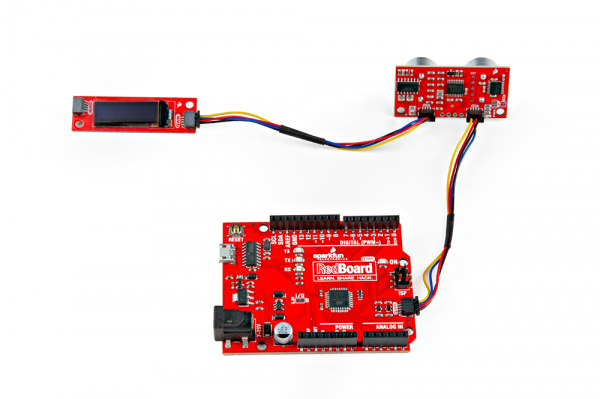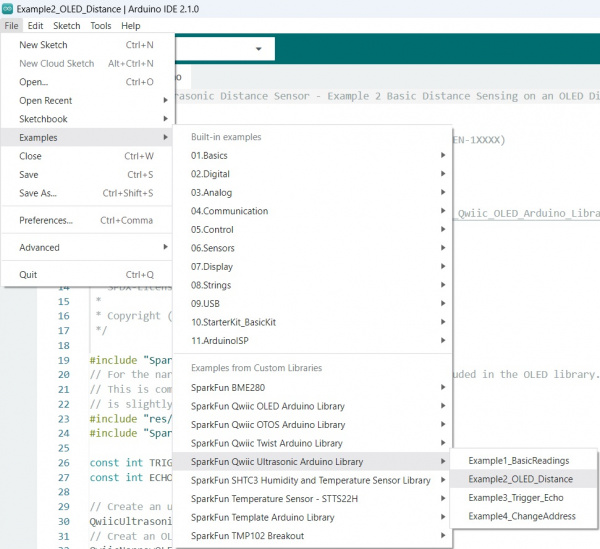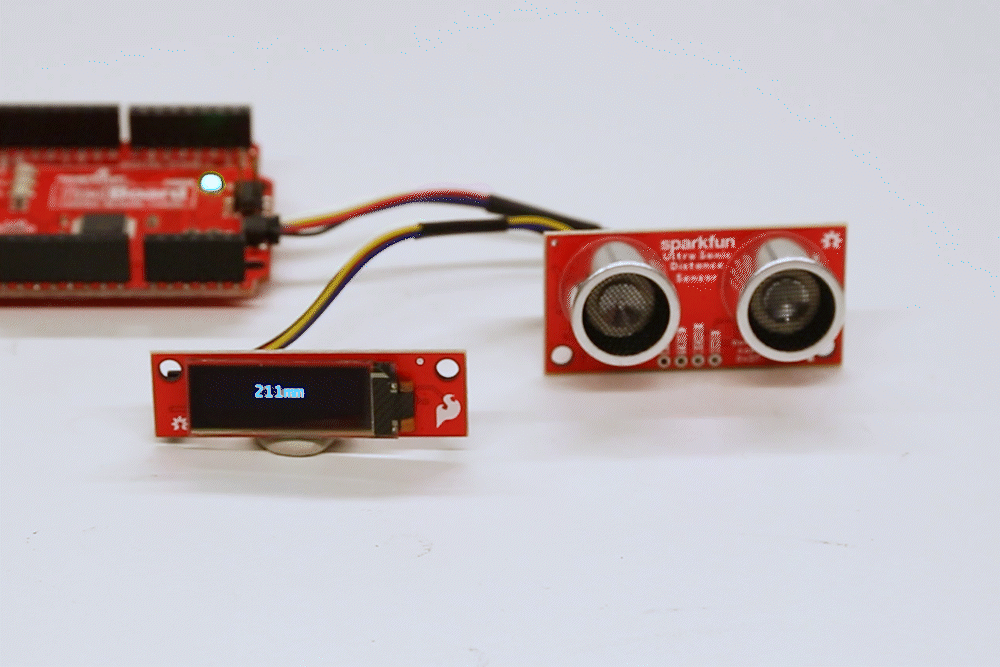Display Distance Measurements On an OLED
Display Measurements On an OLED
Let's add in an LCD screen to display our measurements. For this example you will need another Qwiic Cable and the SparkFun Qwiic OLED Display (0.91 in., 128x32). Again, the Qwiic system makes this example quite literally plug and play. Use Qwiic cables to make your hardware setup look like this:
To display the sensor readings on the connected Qwiic OLED, we will need to install the SparkFun Qwiic OLED library. You can install this library to automatically in the Arduino IDE's Library Manager by searching for "SparkFun Qwiic OLED". Or you can manually download it from the GitHub repository.
To find Example 2, go to File > Examples > SparkFun Qwiic Ultrasonic Arduino Library > Example2_OLED_Distance:
Alternatively, you can copy and paste the code below into a shiny new Arduino sketch:
/* SparkFun Ulrasonic Distance Sensor - Example 2 Basic Distance Sensing on an OLED Display
*
* Products:
* * SparkFun Qwiic Ultrasonic Distance Sensor - HC-SR04 (SEN-1XXXX)
* * https://www.sparkfun.com/1XXXX
* * SparkFun Qwiic Narrow OLED Display (LCD-1XXXX)
* * https://www.sparkfun.com/1XXXX
*
* Link to OLED library: https://github.com/sparkfun/SparkFun_Qwiic_OLED_Arduino_Library
*
* Written By: Elias Santistevan
* Date: 06/2024
*
* SPDX-License-Identifier: MIT
*
* Copyright (c) 2024 SparkFun Electronics
*/
#include "SparkFun_Qwiic_OLED.h"
// For the narrow LED, I prefer the slightly larger font included in the OLED library.
// This is completely optional and can be deleted or commented out. By default the font
// is slightly smaller.
#include "res/qw_fnt_8x16.h"
#include "SparkFun_Qwiic_Ultrasonic_Arduino_Library.h"
// Create an ultrasonic sensor object
QwiicUltrasonic myUltrasonic;
// Creat an OLED object
QwiicNarrowOLED myOLED;
char distanceBuff[4] = {};
String distanceStr = "";
int centerX;
int centerY;
// Here we set the device address. Note that an older version of the Qwiic
// Ultrasonic firmware used a default address of 0x00. If yours uses 0x00,
// you'll need to change the address below. It is also recommended to run
// Example 2 to change the address to the new default.
uint8_t deviceAddress = kQwiicUltrasonicDefaultAddress; // 0x2F
// uint8_t deviceAddress = 0x00;
void setup()
{
Serial.begin(115200); // Default config settings
Serial.println("Ultrasonic Distance Sensor - Example 4 - Distance on an OLED Display");
Wire.begin();
while (myOLED.begin() == false) {
Serial.println("OLED sensor not connected, check your wiring and I2C address!");
delay(1000);
}
while(myUltrasonic.begin(deviceAddress) == false)
{
Serial.println("Ultrasonic sensor not connected, check your wiring and I2C address!");
delay(1000);
}
String hello = "Hello, Ultrasonic!";
// This is good for the narrow OLED screen. You can also just remove this
// and it will default to a slightly smaller font.
myOLED.setFont(QW_FONT_8X16);
// This will center the text onto the screen.
int x0 = (myOLED.getWidth() - myOLED.getStringWidth(hello)) / 2;
int y0 = (myOLED.getHeight() - myOLED.getStringHeight(hello)) / 2;
myOLED.text(x0, y0, hello);
// There's nothing on the screen yet - Now send the graphics to the device
myOLED.display();
delay(2000);
}
void loop()
{
uint16_t distance = 0;
myUltrasonic.triggerAndRead(distance);
// Convert distance, which is an integer, to char so that we can print it.
snprintf(distanceBuff, 6, "%d", distance);
// Put the distance in a string so that we can also print "mm".
distanceStr = distanceBuff;
distanceStr += "mm";
myOLED.erase();
centerX = (myOLED.getWidth() - myOLED.getStringWidth(distanceStr)) / 2;
centerY = (myOLED.getHeight() - myOLED.getStringHeight(distanceStr)) / 2;
myOLED.text(centerX, centerY, distanceStr);
myOLED.display();
delay(250);
}
Make sure you've selected the correct board and port in the Tools menu and then hit the upload button. Once the code has finished uploading, you should see something similar to the following.
Try moving an object (like your hand or a dinosaur) closer to the sensor - notice the output of the OLED shows you how close the object is! Grr. Rawr!


